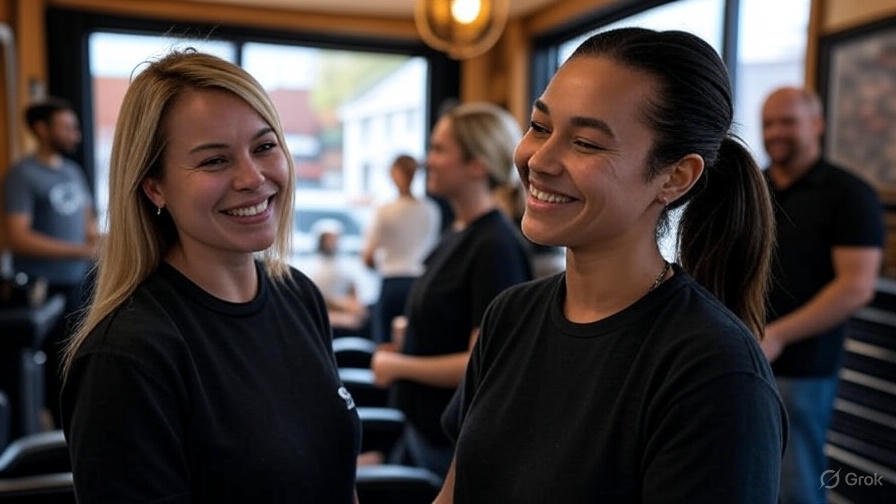Small Town, Big Dreams: The Salon Success Story Sweeping Rural America

Content
In the heart of America’s countryside, where Main Streets stretch past shuttered storefronts and populations are measured in hundreds rather than thousands, an unexpected renaissance is taking root—one perfectly coiffed strand at a time.
Small town salons are experiencing something of a golden age, defying retail trends that have shuttered countless urban establishments and proving that beauty and ambition know no geographic boundaries.
From Decline to Revival
Just five years ago, the story in rural America was largely one of decline. Shopping districts sat empty, young people migrated to cities, and locally-owned businesses struggled to compete with online giants. Salons, requiring personal service and human connection, seemed particularly vulnerable to these demographic shifts.
Today, however, the narrative has dramatically shifted. From Poplar Bluff, Missouri to Bluefield, West Virginia, independent salons are not just surviving—they’re thriving.
The Social Hub Effect
“There’s something magical about what’s happening,” says Maria Rodriguez, who transformed her struggling downtown location into Harmony Salon in Fairbury, Nebraska. “People in small towns don’t just come for haircuts anymore. They come for community.”
Rodriguez’s experience is echoed across rural America. Salons have evolved into social infrastructure—the places where neighbors share news, where business deals are discussed over shampoo bowls, and where community bonds are maintained and strengthened.
Maggie Thompson, owner of Prairie Rose Salon in Havre, Montana, explains: “In a town where everyone knows everyone, we become part of people’s life stories. Weddings, job interviews, first dates—people want to look their best for these moments, and they trust us to help them get there.”
Technology and Tradition
What’s driving this transformation isn’t a rejection of modernity, but rather a savvy integration of it. Successful rural salon owners have embraced social media marketing, online booking systems, and continued education opportunities that were once exclusively urban advantages.
Sarah Chen, who moved from Seattle to open Bloom Salon in her husband’s hometown of McPherson, Kansas, notes: “Instagram has been game-changing for us. I can showcase my work to a global audience while serving my local community. It’s the best of both worlds.”
Economic Impact Beyond Beauty
The success of these salons ripples through entire communities. Each thriving salon represents not just jobs created, but also increased foot traffic for neighboring businesses. When people come downtown for their appointments, they often stay for coffee, shop for clothes, or browse the local bookstore.
The economic multiplier effect is particularly significant in small communities. A full-service salon employing three stylists can contribute more to local economic activity than many larger retail establishments.
Training Grounds for Aspiring Professionals
Rural salons are also becoming unexpected training grounds for the next generation of beauty professionals. Cosmetology schools in urban areas often struggle to provide real-world experience, but small town salons offer apprenticeships and mentorship opportunities that prove invaluable.
Jessica Martinez, who completed her training at a vocational school in Denver before joining her aunt’s salon in Trinidad, Colorado, says: “I learned more in six months here than I did in two years of school. Every client is different, every challenge teaches you something new.”
Challenges and Resilience
Success in small town America is never without its challenges. Stylists face longer drives to continuing education workshops, limited supplier options, and smaller talent pools for hiring. Yet the resourcefulness that defines rural communities has proven to be a significant competitive advantage.
Many salon owners have become creative problem-solvers, sharing resources with neighboring businesses, cross-training in multiple services, and building customer loyalty that transcends typical retail relationships.
A Model for Rural Revitalization
The salon success story offers valuable lessons for other rural businesses. Personal service industries that combine technical skill with relationship building appear particularly well-suited to small town markets. They offer something that online shopping cannot replicate: human connection.
“We’re not just in the beauty business,” reflects Rodriguez. “We’re in the relationship business. And in small towns, relationships are everything.”
Looking Ahead
As these salons continue to flourish, they’re also evolving. Many are expanding into spas, offering specialized services, and becoming destinations for customers willing to travel from larger cities seeking the personal touch and reasonable prices that rural salons provide.
The trend shows no signs of slowing. In an era where authenticity and personal connection are increasingly rare commodities, small town salons have discovered they’re sitting on a goldmine of both.
For rural America, these success stories represent more than individual achievement—they’re proof that with the right combination of passion, adaptability, and community focus, small town dreams can indeed become big realities.
The message from America’s heartland is clear: sometimes the most profound transformations happen not in the shadows of skyscrapers, but in the warm, well-lit spaces where communities gather to look—and feel—their very best.
